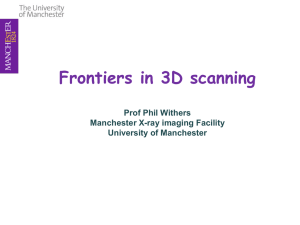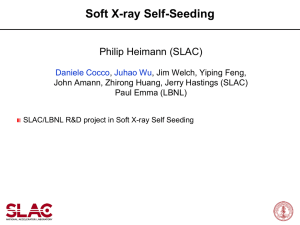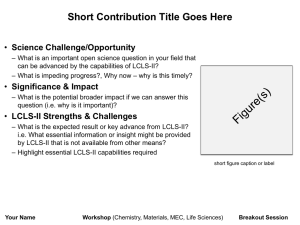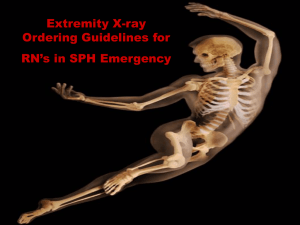Stimulated Electronic X-ray Raman Scattering with XFEL Sources
advertisement
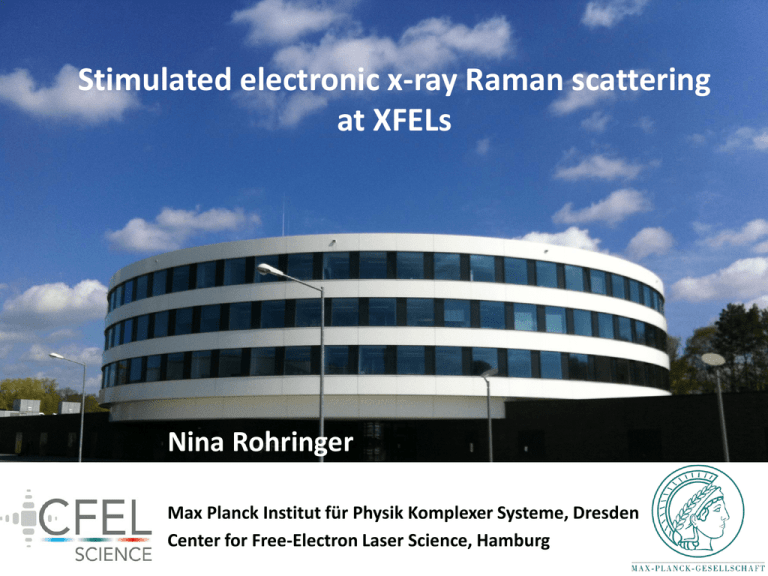
Stimulated electronic x-ray Raman scattering at XFELs Nina Rohringer Max Planck Institut für Physik Komplexer Systeme, Dresden Center for Free-Electron Laser Science, Hamburg Acknowledgements Colorado State University: J.J. Rocca, D. Ryan, M. Purvis LLNL: R. London, F. Albert, J. Dunn, A. Graf, G. Brown LCLS, SLAC: J. Bozek, C. Bostedt, LCLS accelerator / operating team MPI PKS: V. Kimberg, C. Weninger Simultaneous fs X-ray diffraction and photo-emission spectroscopy Probing the electronic structure of the Mn4CaO5 cluster in the oxygen-evolving complex of PS II J. Kern et al, Sciencexpress, 14 February 2013, science.1234273 Intensity [a.u.] SASE XFELs have limited temporal coherence Time [fs] LCLS bandwidth at 1keV photon energy: Dw = 6-9 eV Coherence time: 0.3 - 0.5 fs 1st measurement: I. A. Vartanyants et al. , Phys. Rev. Lett. 107, 144801 (2011) A route to nonlinear spectroscopy with x-rays Stimulated x-ray Raman scattering in atoms X-ray amplification and wave-packet dynamics in molecules I(w) Photoionization atomic inner-shell x-ray laser w w Ne Ne+ Rohringer et al., Nature 481, 488 (2012) C. Weninger et al., under review (2013) Kimberg & Rohringer, PRL 110, 043901 (2012) Upcoming experiments: LCLS, Feb. 2014 FLASH, Oct. 2014 1st theoretical concept of an atomic x-ray laser Population inversion by inner-shell photoionization 1st X-ray laser proposed back in 1967: Duguay & Rentzepis, Appl. Phys. Lett. 10, 350 (1967). Ultrafast ionization of inner-shell electrons 1st realization in the optical regime (blue laser): Silfvast et al., Opt. Lett. 8, 551 (1983). Fast, powerful x-ray pump required to beat Auger decay ! Photo-ionization inner-shell x-ray laser, Neon Coherent amplification of fluorescence Focused XFEL beam I(z, t) = I(0, t)× e g(z,t )×n×z Atomic gas volume Duguay & Rentzepis, Appl. Phys. Lett. 10, 350 (1967). N. Rohringer & R. London, PRA 80, 013809 (2009) Atomic x-ray laser (amplified spontaneous emission) Schematic experimental setup Grating spectrometer LCLS beam Gas cell filled with Neon grating focusing chamber AMO high-field chamber Hutch 1 (AMO) grating spectrometer Hutch 2 (SXR) Diagnostics: - Inline spectrometer for monitoring transmitted XFEL and amplified scattered x rays - Grating spectrometer for scattered/fluorescent x rays Single shot of highest intensity: 8×109 photons in Ne K-a line corresponding to GL 21-23 1.2e+06 run 239, shot 18 run 239, shot 32 run 239, shot 45 Integrated counts 1e+06 800000 FWHM 2 eV (instrumental resolution) 600000 400000 FWHM 10 eV 200000 0 820 840 860 880 900 920 940 960 980 1000 Photon energy [eV] XFEL input output Photon energy 940 eV 849 eV Pulse energy 0.25 mJ 1.1 mJ Number of photons 1.6 x 1012 8 x 109 Pulse duration 40 fs 0.5-5 fs (calculated) Bandwidth 10 eV 0.25 eV (calculated) Coherence time 0.3 fs full temporal coherence Gas pressure: 500Torr Focal radius: 1-2 mm Interaction length: 1.6 cm Rohringer et al., Nature 481, 488 (2012) Pumping-power dependence of Ne K-a transition (every point corresponds to an average over 10 LCLS shots) Average GL = 19-21.3 @ pulse energy of 0.25 mJ Rohringer et al., Nature 481, 488 (2012) A route to nonlinear spectroscopy with x-rays Stimulated x-ray Raman scattering in atoms X-ray amplification and wave-packet dynamics in molecules I(w) Photoionization atomic inner-shell x-ray laser w w Ne Ne+ Rohringer et al., Nature 481, 488 (2012) C. Weninger et al., under review (2012) Kimberg & Rohringer, PRL 110, 043901 (2012) LCLS, Sept. 2010 LCLS, Aug. 2011 Upcoming experiments: LCLS, Feb. 2014 FLASH, Oct. 2014 X-ray pumping of Neon near the K-edge LCLS bandwidth: 7 eV Total ion yield [1s]3p 867.2 eV 3 eV [1s]4p 868.8 eV FWHM 0.27 eV D. V. Morgan et al., PRA 55, 1113 (1997) 3p 2p 2s 2p 2s 1s 1s K edge 2p 2s 1s-3p Stimulated Electronic X-ray Raman Scattering 7 eV FWHM K edge 3p 2p 2s 1s Weninger et al., under review (2013) 1s-3p Emitted line profile as a function of pump photon energy K edge Weninger et al., submitted (2013) Stochastic line shift due to “anomalous” linear dispersion of resonance scattering 1st RIXS experiments on Cu with Synchrotron radiation (1976) Continuum wout Detuning, D win wout win P. Eisenberger, P.M. Platzman, H. Winick, PRL 36, 623 (1976). Width of resonance: 0.25 eV Width of SASE spike: Dw=1/t =0.1 eV Master Equations for atomic and ionic density matrices coupled to Maxwell’s equation Effective sRIXS cross section as a function of propagation depth RIXS process dominated by 5 spectral intensity spikes – 5 distinct modes in the emitted spectrum Simulated spectral / temporal intensity profiles of sRIXS process Simulated Single-Shot Raman Spectra Coupled generalized Maxwell-Bloch equations K edge Line profile – comparison of experiment to simulation Experiment K edge Weninger et al., submitted (2013) Theory Raman Signal Strength as a Function of Pump Energy Number of seed photons: 103-104 (varying due to spectral sidebands of the XFEL) Estimated number of photons of spontaneous RIXS: 100 Saturated amplification by 7-8 orders of magnitude Weninger et al., submitted (2013) High-resolution x-ray Raman spectroscopy by statistical analysis (covariance mapping) Covariance map from 5000 simulated single-shot spectra Weninger&Rohringer, in preparation Self-stimulated x-ray emission processes in diatomic molecules Valence excited Ground XFEL pump XFEL pump Ground Core-ionized X-ray emission Atomic lasing Core-ionized X-ray emission XFEL pump Core-excited, dissociative Valence dissociative Ground Kimberg & Rohringer, PRL. 110, 043901 (2012). Q. Miao, J.-C. Liu, H. Agren, J.-E. Rubensson & F. Gel’mukhanov, PRL 109, 233905 (2012). Victor Kimberg Photo-ionization X-ray lasing scheme in molecular Nitrogen Fluorescence spectrum 2S + u 3sg-1 3sg-1 1S + g [1] B. Kempgens, et al. J. Phys. B 29, 5389 (1996) [2] P. Glans, et al. J. El. Spec. Rel. Phen. 82, 193 (1996) Alignment of the molecule matters Impulsive (field-free) laser alignment of the molecular ensemble aligned ensemble <cos2q>=0.8 isotropic ensemble Contours of the 3sg orbital (final state) E q Number of emitted x-ray photons as a function of the incoming XFEL photon number (50 fs pulse duration, 1.5 mm focus) Impulsive laser alignment Degree of alignment for various laser parameters and temperatures Aligned ensemble 800 nm, 110 fs, 6x1013 W/cm2 : 1 – 100 K : <cos2q>=0.62; 0.164 2 – 300 K : <cos2q>=0.5; 0.22 800 nm, 100 fs, 1x1014 W/cm2 : 3 – 100 K : <cos2q>=0.70 4 – 50 K : < cos2q>=0.77 Anti-Aligned ensemble Emission spectra for two different electronic final states 3sg-1 1pu-1 fluorescence spectrum <cos2q>= 0.5 <cos2q>=0.77 <cos2q>=0.22 Stimulated X-ray Raman scattering to study charge transfer Dt w1 Start valence/vibrational wavepacket at atomic site A w2 Dt w3 ws “charge transfer” Probe at atomic site B S. Mukamel et al. ( PRL 89, 043001 (2002), PRB 72, 235110 (2005); PRA 76, 012504 (2007); PRB 79, 085108 (2009) Evolution of emitted spectrum FEL input: transform limited 5 fs pulse, 2.5 x 1012 photons (LCLS II) Emission shift to w=2w00-w22 Propagation depth [mm] Shift of emission frequency due to 4-wave mixing Saturation broadening Onset of saturation Energy [eV] Kimberg & Rohringer, PRL. 110, 043901 (2012). Stimulated x-ray Raman scattering creates Vibrational and electronic wave-packet normalized 0.01 Internuclear distance [a.u.] Final state Internuclear distance [a.u.] normalized Internuclear distance [a.u.] Time [fs] 0.1 1 Time [fs] Intermediate state Internuclear distance [a.u.] Different ways to for stimulated X-Ray Raman scattering 1. Two-color Raman scattering with seeded source Pick 2 distinct frequencies within 10 eV SASE bandwidth allows selection of intermediate and final state 2. Impulsive Raman scattering with seeded source “attosecond pulses”, broad bandwidth transform limited pulse (10 eV bandwidth, 0.25 fs pulse duration) 3. Impulsive Raman with broadband SASE temporal resolution limited to coherence time of source for non-linear processes depending on higher-order field correlation functions N. Morita and T. Yajima, PRA 30, 2525 (1984). Y. H. Jiang et al., PRA 81, 051402(R) (2010). M. Belsley et al. PRA 64, 063806 (2001). K. Meyer et al., PRL 108 098302 (2012), Two-color SASE XFEL operation Relative separation of the pulses: ≈ 2% of central photon energy SASE bandwidth of each indiviual pulse: ≈ 0.5% of central photon energy Two pulses can be delayed within electron bunch length Lutman et al., Phys. Rev. Lett. 110, 134801 (2013). Simulated sRIXS spectra on p* resonance in CO using two-color SASE mode Intensity [arb. units] preliminary stimulated emission Photon energy [eV] stimulated emission on „elastic“ peak Challenge: Find regime of best signal contrast ( to at least 10% change) Summary and Outlook New Results Stimulated x-ray emission processes are accessible at XFELS 1st atomic inner-shell x-ray laser based on photoionization 1st demonstration of stimulated (impulsive) electronic x-ray Raman scattering Directions Transfer of stimulated emission processes to molecules (gas phase) 2 upcoming experiments in 2014 Feasibility studies of stimulated x-ray Raman scattering in liquids and solids Opportunities Use XFELs to pump electronic/vibrational wave packets Development of new all x-ray (and x-ray / optical) pump probe techniques Nonlinear x-ray spectroscopy Postdoctoral position in experimental AMO physics available in our group at CFEL in Hamburg nina@pks.mpg.de Project: demonstrate a molecular x-ray lasing and stimulated RIXS in CO and N2 at 2 upcoming beam-times at the LCLS and FLASH XFEL Outlook for stimulated X-ray Raman scattering in molecules at SASE XFELs sRIXS in forward direction: - in principle high energy resolution, limited by spectral coherenc of SASE pulses - only limited access to transitions of different symmetry - strong pre-edge resonance - seeding with tails of FEL pulses not possible - two-color SASE scheme necessary - covariance mapping: probably not sufficient to measure the transmitted spectrum - need to measure the incoming SASE spectrum – cross correlation - good control of relative intensities of the two SASE modes - Rydberg states: currently being investigated - we suspect higher gains despite smaller pump dipole transition strength Polarization of emitted radiation control by pre-aligned sample Example: transition dipole parralel to molecular axis optical alignment laser s XFEL a XFEL s 800nm s XFEL a s molXRL k Pumping power requirements for x-ray lasers I(z) = I(0)× eg×z Population inversion: Gain coefficeint: Dn Einstein A coefficient: Naturally broadened transition (rad. decay): E2,N2,g2 l,n, A21 E1,N1,g2 E0 Required pump power density to compensate for level depletion: Pumping power to maintain a specific gain: J. J. Rocca, Rev. Scient. Instr. 70, 3799 (1999). Small-signal gain cross section Single shot – versus ensemble average FWHM 20 fs Gain at gas density of 1.6e19 atoms/cm3: G=rs =64 cm-1 Slow-down of group velocity on resonance Gain-guiding, due to absorption of pump occupation of upper state No pump absorption occupation of upper state normalized normalized (see also Casperson & Yariv, PRL 26, 293 1971) normalized Population Evolution of bond-length in excited and final state for a pump pulse of 50 fs z=2 mm z=3 mm z=5 mm 0.2 0.1 x 20 <ri> (Å) 0 1.09 (a) Population of Intermediate (core-excited) state (b) Bond-length of intermediate state 1.08 1.07 (c) <rf> (Å) 1.14 Bond-length of final state 1.12 1.1 -40 Incoherent superposition Of final vibrational states -20 0 20 40 60 Retarded time (fs) Kimberg & Rohringer, PRL. 110, 043901 (2012). Fine Tuning of the emission Emission energy (eV) v=2 V=1 v=0 Interaction length (mm) Evolution of XFEL pump pulse and emitted XRL pulse through the gain medium SASE Pulse 1 SASE Pulse 2 XFEL distance [mm] distance [mm] XFEL normalized XRL distance [mm] distance [mm] XRL normalized Beam profiles of LCLS and XRL in the far field 1 atomic XRL transmitted XFEL Intensity [arb. units.] 0.8 0.6 0.4 0.2 0 0 0.5 1 1.5 2 2.5 3 3.5 4 4.5 5 Position [mm] FEL and XRL have the same angular divergence, ~ 1 mrad Rohringer et al., Nature 481, 488 (2012) The build-up of transform-limited pulses Number of photons Gaussian pulse, 40 fs, 2 x 1012 photons; Length: 16 mm, Density: 1.6 x 1019 cm-3 1.e12 Saturated gain region 1.e08 1.e04 1.e00 Linear gain region no spectral gain narrowing transform limited pulses Weninger & Rohringer, in preparation see also: Hopf et al., PRL 35, 511 (1975); Hopf & Meystre, PRA 12, 2534 (1975) Vibrational and electronic wave-packet dynamics Internuclear distance [a.u.] normalized Time [fs] Time [fs] Intermediate state normalized Time [fs] Time [fs] Internuclear distance [a.u.] final state Internuclear distance [a.u.] Internuclear distance [a.u.] z= 3 mm (exp. gain regime) X-ray absorption cross section N2



